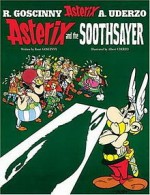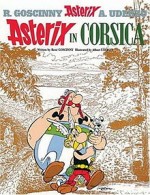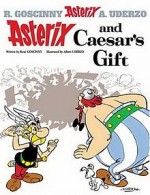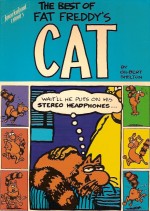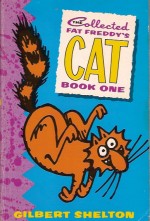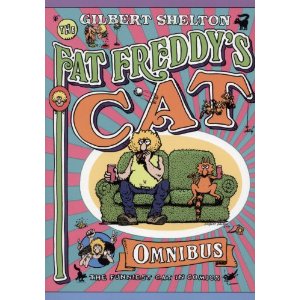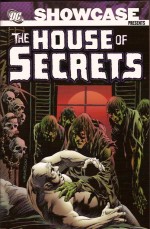
By many and various (DC Comics)
ISBN: 978-1-84856-472-5
With superheroes on the decline again in the early 1970s, four of the six surviving newsstand comicbook companies (Archie, Charlton, DC, Gold Key, Harvey and Marvel) relied increasingly on horror and suspense anthologies to bolster their flagging sales. Even wholesome Archie briefly produced Red Circle Sorcery/Chillers comics and their teen-comedy core moved gently into tales of witchcraft, mystery and imagination.
DC’s first generation of mystery titles had followed the end of the first Heroic Age when most of the publishers of the era began releasing crime, romance and horror genre anthologies to recapture the older readership which was drifting away to other mass-market entertainments like television and the movies.
As National Comics in 1951, the company bowed to the inevitable and launched a comparatively straight-laced anthology – which nevertheless became one of their longest-running and most influential titles – with the December 1951/January 1952 launch of The House of Mystery.
When a hysterical censorship scandal led to witch-hunting hearings attacking comicbooks and newspaper strips (feel free to type Senate Subcommittee on Juvenile Delinquency, April-June 1954 into your search engine at any time) the industry panicked, adopting a castrating straitjacket of stringent self-regulatory rules and admonitions.
Even though mystery titles produced under the aegis of the Comics Code Authority were sanitised and anodyne affairs in terms of Shock and Gore, the appetite for suspense was still high, and in 1956 National introduced the sister title House of Secrets which debuted with a November-December cover-date.
Supernatural thrillers and monster stories were dialled back into marvellously illustrated genteel, rationalistic, fantasy-adventure vehicles which nonetheless dominated the market until the 1960s when the super-hero (which had begun a renaissance after Julius Schwartz reintroduced the Flash in Showcase #4, 1956) finally overtook them. Green Lantern, Hawkman, the Atom and a host of other costumed cavorters generated a gaudy global bubble of masked myrmidons which even forced the dedicated anthology suspense titles to transform into super-character split-books with Martian Manhunter and Dial H for Hero in House of Mystery and Mark Merlin – later Prince Ra-Man – sharing space with anti-hero Eclipso in House of Secrets.
When the caped crusader craziness peaked and popped, Secrets was one of the first casualties and the title folded with the September-October 1966 issue.
However nothing combats censorship better than falling profits and at the end of the 1960s the Silver Age superhero boom busted again, with many titles gone and some of the industry’s most prestigious series circling the drain too…
This real-world Crisis led to the surviving publishers of the field agreeing to loosen their self-imposed restraints against crime and horror comics. Nobody much cared about gangster titles at the time but as the liberalisation coincided with another bump in public interest in all aspects of the Great Unknown, the resurrection of scary stories was a foregone conclusion and obvious “no-brainer.â€
Thus with absolutely no fanfare at all House of Secrets rose again with issue #81, (cover-dated August-September 1969) just as big sister House of Mystery had done a year earlier.
Under a spooky bold banner declaiming “There’s No Escape From… The House of Secretsâ€, creators veteran and neophyte churned out a massive deluge of spooky, creepy, wryly tongue-in-cheek and scary tales, all introduced by the innocuous and timid Abel; caretaker of a  ramshackle, sentient old pile temporarily located somewhere in the Dark Heart of the USA…
This second enthralling and economical monochrome Showcase compendium collects the chilling contents of issues #99-119, spanning August 1972 – September 1973, and also features a stellar selection of covers from artists Michael Kaluta, Bernie Wrightson, Nick Cardy, Jack Sparling and Luis Dominguez.
‘Welcome to the House of Secrets’ by E. Nelson Bridwell & Wrightson began another pensive package of terrors after which ‘Beyond His Imagination’ by Bill Meredith & Nestor Redondo saw a comicbook artist travel to the other side of death in search of inspiration, after which ‘Beat the Devil’ (Jack Oleck, Jack Katz & Tony DeZuniga) dealt with a religious thief who repented too late before ‘Goodbye, Nancy’ by John Albano, Vic Catan, Frank Redondo & Abe Ocampo saw a lonely child go to lethal lengths in her attempts to find a playmate…
A huge boost to the battered American industry at his time was the mass hiring of a flight of top Filipino artists whose stylish realism, experience in many genres and incredible work ethic made them an invaluable and highly influential factor of the horror boom. This collection especially is positively brimming with their superb illustrative excellence.
First in issue #100 however is ‘Round-Trip Ticket’ by Lore Shoberg & Tom Palmer, wherein a hippy truth-seeker learns a little more about alternate lifestyles than he bargained for. These comics chillers were frequently leavened by the mordant and wordless cartoon gags of the legendary Sergio Aragonés, who here contributes a trio of gems starring ‘Cain & Abel’ before Oleck, Mike Sekowsky & Dezuniga reveal the fate of an escaped convict who briefly became ‘The Man Who Stopped Time!’ After a page of ‘Abel’s Fables’ cartoons by Shoberg, Oleck & Alfredo Alcala brought the issue to a close with the dark period Voodoo yarn ‘Rest in Peace’…
Clever science fiction courtesy of Sheldon Mayer & Alex Niño opened #101 as ‘Small Invasion’ told a tale of love, double-cross and vengeance when an alien infiltrator discovers true romance whilst preparing to destroy humanity, after which ‘The Sacrifice’ (Oleck & June Lofamia) pitted Witch against Warlock in a game as old as time… Aragonés’ ‘Cain & Abel’ page then precedes ‘Hiding Place’ by Raymond Marais & Ruben Yandoc, with a murderous gangster picking the wrong home to invade after which an ‘Abel’s Fables’ page by Shoberg brings the issue to a close.
‘Make a Wish’ by Oleck & E.R. Cruz, led in #102 as a troubled boy periodically escapes the real world – until well-meaning adults take him in hand, whilst ‘The Loser’ (Oleck, Quico Redondo & Ocampo) details a hen-pecked husband who can’t even get his revenge right, and bracketed between a brace of Aragonés’ ‘Abel’s Fables’ Albano & Nestor Redondo shone with the salutary romantic chiller starring ‘A Lonely Monstrosity’…
House of Secrets #103 began with a tale on con men and time travel in ‘Waiting… Waiting… Waiting’ by Mayer & Rico Rival, whilst ‘No Bed of Roses’ (Albano & Sparling) told a unique tale of reincarnation and revenge, before a post-apocalyptic revelation proved that man could never change in ‘The Village on the Edge of Forever’ by Steve Skeates & Niño, before Aragonés wrapped another issue with one of his ‘Cain & Abel’ pages.
In #104 ‘Ghosts Don’t Bother Me… But…’ by Mayer & Nestor & Virgilio Redondo told the sorry story of a hitman who found that his victims didn’t always rest in peace, whilst ‘The Dead Man’s Doll’, by Bill Riley & Alcala and book-ended by two ‘Abel’s Fables’ by Aragonés and Albano, saw a beloved puppet take vengeance for his owner when the frail fellow was murdered by his uncaring carers, whilst ‘Lend Me an Ear!’ by Oleck & George Tuska, saw merciless college pranksters hoisted on their own petard after playing in a morgue…
Issue #105 featured ‘Vampire’ an effective game of Ten Little Indians played out in an old Nevada mine by Maxene Fabe & Gerry Taloac, the gloriously dry ‘Coming Together!’ (Skeates & Jim Aparo) which showed that courage wasn’t everything when demons invaded a small town, and a great old-fashioned murdered man’s revenge yarn in ‘An Axe to Grind’ by Skeates & Alcala, whilst #106, after a magical ‘Welcome to the House of Secrets’ by E. Nelson Bridwell & Wrightson, opened with ‘The Curse of Harappa’ (Fabe & Yandoc) as a man dedicated to wiping out superstition found it wasn’t all nonsense, after which ‘The Island of No Return’ by Albano & Niño displayed the epitome of monstrous abiding terror, and Oleck and Alcala closed the show with a turn-of-the-century joker getting his just desserts in ‘This Will Kill You’.
In #107 Alcala illustrated Oleck’s ‘Skin Deep’ a dark tale of magic masks and ugly people in New Orleans and, after an Aragonés ‘Cain & Abel’, Arnold Drake’s hilarious hen-pecked howler ‘The Night of the Nebish!’ before ‘Winner Take All’ by Skeates & Bernard Baily restores some lethal gravitas to the proceedings when a greedy tramp learns too late the life-lesson of when to let go…
In #108 ‘Act III Eternity’ by George Kashdan & Jess Jodloman describes how a washed up thespian unsuspectingly took method acting to unfortunate extremes whilst ‘A New Kid on the Block’ (Fabe & Rival) found a new wrinkle in the hoary legend of revivified mummies and ‘The Ghost-Writer’ by Riley & Taloac saw a dissolute author finally pay for taking undeserved credit during his successful career. This issue also featured two more bleak and black ‘Abel’s Fables’ by Aragonés,
HoS #109 held two longer tales; ‘Museum of Nightmares’ by Michael Pellowsky, Fabe & Alcala, in which animated waxworks haunted the last case of a great detective whilst in ‘…And in Death there is No Escape!’, (Albano & Niño) a callous bluebeard and actor of towering ego at last regretted the many sins that had led him to physical immortality and infamous renown. Issue #110 opened with an entertaining vampire tale in ‘Domain of the Dead’ by Oleck & Fred Carrillo, continued with supernatural murder-mystery ‘Safes Have Secrets Too’ by Pellowsky, Fabe & Flor Dery and finished on a beguiling high note with Oleck & Taloac’s ‘Possessed’ as a simple farmer searched in all the wrong places for a deadly witch…
Gerard Conway & Dezuniga provided a haunting tale of lonely lighthouses and other worlds in #111’s ‘A Watchtower in the Dark’, after which ‘Hair-I-Kari’ by Fabe & Romy Gamboa told a sordid tale of a magic baldness cure and Michael Fleisher & Taloac recounted a bold adventurer’s quest to defeat death in ‘The Land Beyond the Styx!’
In #112 ‘The Witch Doctor’s Magic Cloak’ by Fleisher & Rudy Nebres explored the grotesque consequences of alternative medicine and limb regeneration, after which Conway & Luis Dominguez pastiched Sherlock Holmes to great effect in ‘The Case of the Demon Spawn!’ whilst #113 opened with an all-out monster mash in the delightfully dark ‘Not So Loud – I’m Blind!’ by Doug Moench, Nick Cardy & Mike Sekowsky and after another Aragonés ‘Abel’s Fables’ Oleck & Nestor Redondo unleashed a truly nasty tale of child vampires in ‘Spawns of Satan’ …
HoS# 114 led with Fleisher & Frank Bolle’s ‘Night Game’ – a chilling sports-story of corruption in hockey and murder on ice – and close with the same writer’s ‘The Demon and the Rock Star!’, concerning one Hell of a comeback tour and illustrated by Talaoc, whilst #115 featured ‘Nobody Hurts my Brother!’ by Drake & Alcala: a tale of once-conjoined twins who shared each others hurts but not morals, after which ‘Remembered Dead’ (Kashdan & Niño) dealt with a wax museum guard’s unhealthy attachment to one of the exhibits, and ‘Every Man my Killer!’ by Kashdan and Nardo & E.R. Cruz, followed a tormented soul the entire world wanted dead…
‘Like Father, Like Son’ by Oleck & Nestor Redondo in #116 followed the rise and fall of a 18th century peasant who sold more than his soul for wealth, love and power, and ‘Puglyon’s Crypt’ by David Michelinie & Ramona Fradon explored with delicious vivacity the obsession of a man determined never to suffer premature burial…
House of Secrets #117 opened with a tale of medieval feuds and bloody vendettas that inevitably led to ‘An Eye for an Eye’ (Oleck & Ernie Chan), whilst ‘Don’t Cry for Uncle Malcolm’ Gerry Boudreau & Niño provided a phantasmagorical glimpse at the power of modern Voodoo, after which another couple of Aragonés ‘Abel’s Fables’ bracket a wickedly ironic vignette entitled ‘Revenge For the Deadly Dummy!’ by Skeates Alcala.
The sinister magic of Hollywood informs the chilling delayed vengeance saga ‘The Very Last Picture Show’ by Fleisher & George Evans which opens #118, after which a ghostly ‘Turnabout’ (Skeates & Quico Redondo) proves too much for a cunning murderess, and Oleck & Fradon display a different look at leprechauns in ‘Nasty Little Man’…
This compendium concludes with issue #119 and ‘A Carnival of Dwarfs’ by Fleisher & Arthur Suydam, wherein an unscrupulous showbiz impresario comes between a gentle old man and his diminutive friends, and wedged between two last ‘Cain & Abel’ pages by Aragonés, Pellowsky, Kashdan & Alcala proved that primitive people are anything but when a callous anthropologist provided an ‘Imitation Monster!’ for an isolated tribe and lived to regret his foolishness…
If you crave witty, beautifully realised, tastefully splatter-free sagas of tension and imagination, not to mention a huge supply of bad-taste, kid-friendly cartoon chills, book your return to the House of Secrets as soon as you possibly can…
© 1972, 1973, 1974, 2009 DC Comics. All Rights Reserved.

